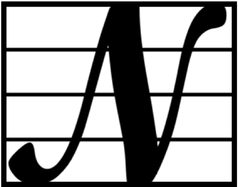An introduction to Chronota
Chronota makes it possible to notate chromatics whithout accidentals. This notation can be used parallel to the traditional notation and is suitable for all types of music.
Many already known components are kept, such as the five line staff. In contrast it does away the usual clefs and accidentals.
What is new?
"N" is the new Chronota clef. It comes at the beginning of each Chronota passage and the relevant pctave. Each tone has the same positioon the staff in every octave. Large jumps in pitch can be notated with either new octave sign (a small numeral after the "N") or by using ledger lines. In print, the note heads in Chronota are square to differentiate them from normal notes; this avoids confusion. When hand-written the shape of the note head is not so important, as it is the Chronota clef which designates the subsequent passage.
Chronota's strengths correspond to the weaknesses of conventional music notation and vice versa. Both notations complement each other, but zhey do not compete with one another and can be used alternately, even in short passages. These possibilities can be applied in many ways.
Chronota is also well-suited for New Music, and contemporarycomposers will Chronota the benefits. Chromatic accidentals, which are not nessesary in chronota, take on a new function: Microtones. These can now be easily notated and reyd in Chronota - without additional special accidental symbols.
Chronota & Tradition:
In traditional notation, semitone and whole tone steps are not easy to recognize. A further problem is the use of different clefs, whereby each tone has a different position on the staff.
Chronota elimenates these problems by very simple means and can be ealily integrated into already existing scores. The structure remains the same, and existing music paper can be used.
Next page: Notation examples and further information...
